
Flare Probabilities [%] (00:00 UTC +24H) ?
| NOAA ? | C+ | M+ | X+ | Mean ? | ||||||||
|---|---|---|---|---|---|---|---|---|---|---|---|---|
| MCEVOL ? | MCSTAT ? | SWPC ? | MCEVOL | MCSTAT | SWPC | MCEVOL | MCSTAT | SWPC | C+ | M+ | X+ | |
| 13690 | 6 | 5 | 5 | 0 | 0 | 1 | 0 | 0 | 1 | 5 | 0 | 0 |
| 13691 | 98 | 76 | 60 | 81 | 33 | 20 | 0 | 4 | 10 | 78 | 45 | 5 |
| 13693 | 12 | 9 | - | 0 | 0 | - | 0 | 0 | - | 10 | 0 | 0 |
| 13695 | 14 | 22 | 15 | 1 | 2 | 1 | 0 | 0 | 1 | 17 | 1 | 0 |
| 13697 | 79 | 92 | 99 | 16 | 35 | 60 | 0 | 5 | 30 | 90 | 37 | 12 |
| 13698 | 0 | 44 | 40 | 0 | 4 | 10 | 0 | 0 | 1 | 28 | 5 | 0 |
| 13699 | 17 | 33 | 15 | 2 | 4 | 1 | 0 | 0 | 1 | 22 | 2 | 0 |
| 13700 | - | 57 | 60 | - | 6 | 15 | - | 0 | 1 | 59 | 11 | 1 |
| 13701 | - | 55 | 15 | - | 4 | 1 | - | 0 | 1 | 35 | 3 | 0 |
SolarMonitor's flare prediction system's probabilities are calculated using the NOAA Space Weather Predicion Centre's McIntosh classifications. There are two methods, MCSTAT and MCEVOL, that use sunspot-group McIntosh classifications and Poisson statistics to calculate flaring probabilities valid for a 24-hr period starting at 00:00 UTC. The flaring probabilities are calculated using historical data from solar cycles 23 and 24 (1996-2019).
MCSTAT (McIntosh Statistics): Uses the point-in-time McIntosh classification to calculate Poisson flaring probabilities. Details about the method [1] and forecast verification testing [2] can be found in the following papers:
[1] Gallagher, P. T., Moon, Y.-J., Wang, H., Solar Physics, 209, 171, (2002)
[2] Bloomfield et al., 2012, The Astrophysical Journal Letters, 747, L41
[1] McCloskey, A.E., Gallagher, P.T. & Bloomfield, D.S., Solar Physics, 291, 1711, (2016)